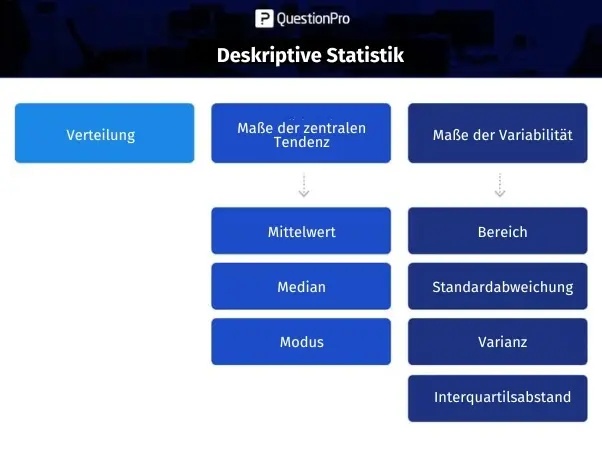Market research
There are mathematical calculations that allow us to extract a true positive or negative trend of results from the data. Just those descriptive statistics helps us analyse and describe the data to arrive at a final result.
It is said that descriptive statistics are the basis for every Intelligent Data Analysis is. Let's learn more about their features and types.
CONTENT
- 1 What is descriptive statistics?
- 2 Aims of descriptive statistics
- 3 The importance of descriptive statistics
- 4 Types of descriptive statistics
- 5 Examples of descriptive research
- 6 Difference between descriptive statistics and inferential statistics
- 7 Conclusion
- 8 1:1 Live Online Presentation: QUESTIONPRO MARKET RESEARCH SOFTWARE
- 9 Try software for market research and experience management now for 10 days free of charge!
What is descriptive statistics?
The term descriptive statistics refers to the analysis, summary and presentation of results with respect to a data set derived from a sample or the entire population.
Descriptive statistics include three main categories: frequency distribution, measures of central tendency, and measures of variability.
Descriptive statistics are understood to mean e.g. B. calculating the mean and the median, two very important and, above all, different indicators. The median is an indicator that “does not take into account extreme, sometimes rare values,” in contrast to the mean, which is heavily influenced by these extreme values.
Aims of descriptive statistics
The aim of descriptive statistics is to describe the observed data in a synthetic and meaningful way in order to better analyse it. It involves collecting observations about people with a particular trait and translating those observations into numbers that provide information about that trait.
In short, it aims to structure and present the information contained in the data.
The importance of descriptive statistics
Descriptive statistics make data visualization easier. They enable a meaningful and understandable presentation of the data, which in turn enables a simplified interpretation of the data set in question.
Raw data is difficult to analyse, and identifying trends and patterns can be challenging. Additionally, with raw data, it is difficult to visualize the data.
The use of descriptive statistics allows a data set to be summarized and presented through a combination of tabular and graphical descriptions. Descriptive statistics are used to summarize complex quantitative data.
Types of descriptive statistics
Descriptive statistics help describe and understand the characteristics of a particular data set by providing brief summaries of the sample and measures of the data.
These are the types of descriptive statistics:
Frequency distribution
Used for both qualitative and quantitative data. It represents the frequency or number of different results in a data set or sample.
The frequency distribution is usually presented in a table or graph. Each entry in the table or chart is accompanied by the number or frequency of occurrence of the values in a particular interval, range, or group.
Frequency distribution is basically a representation or summary of grouped data classified according to mutually exclusive classes and the number of occurrences in each respective class. It enables a more structured and organized presentation of the raw data.
The most common charts and graphs used to represent and visualize frequency distribution include bar charts, histograms, pie charts, and line charts.
Central tendency
Central tendency is another type of descriptive statistics and refers to the descriptive summary of a data set using a single value that reflects the center of the data distribution.
Measures of central tendency are also known as measures of centrality. The Mean, the median and the mode are considered measures of central tendency.
The mean, considered the most popular measure of central tendency, is the average or most common value in a data set. The median refers to the middle value of a data set in ascending order. Mode refers to the most common score or value in a data set.
variability
A variability measure is a summary statistic that reflects the degree of dispersion in a sample. Variability measures determine the distance that the data points appear to be from the center.
Spread and variability refer to and denote the range and width of the distribution of values in a data set. The range, the standard deviation and the Variance are each used to represent different components and aspects of variation.
The range represents the degree of dispersion or an ideal of the distance between the highest and lowest values within a data set. The standard deviation is used to determine the average variance of a data set and gives an idea of the distance or difference between a value in a data set and the mean of the same data set.
The variance reflects the degree of dispersion and is essentially an average of the squared deviations.
Examples of descriptive research
Here are some examples of using descriptive research:
1 example:
Descriptive statistics about a university refer to the average math test scores of entering students. It says nothing about why the data is the way it is or what trends we can identify and track.
Descriptive statistics help simplify large amounts of data in meaningful ways. It reduces a lot of data to a summary.
2 example:
They conducted a survey among 40 respondents about their favorite car color. Now you have a worksheet with the results.
However, this table is not very meaningful and you want to summarize the data with some charts and tables from which you can draw some simple conclusions (e.g. 24% of respondents said white is their favorite color).
That would certainly be much more representative and clearer than an ugly table. You also have many options for visualizing data, e.g. B. Pie charts, line charts, etc.
This is the core of descriptive statistics. Remember, you are not drawing conclusions about the entire population.
Difference between descriptive statistics and inferential statistics
Descriptive statistics provide an accurate summary of the data. You can summarize the data in numerical or graphical form. For example, the manager of a fast-food restaurant analyses customer wait times at lunchtime for a week and then summarizes the data.
Within the Inferential statistics a sample of data from a population is used to describe and draw conclusions about the population. Inferential statistics are relevant when it is difficult or impossible to study all members of a population.
For example, it is not possible to measure the diameter of all nails produced. However, it is possible to measure the diameters of a representative sample of nails and use this information to draw general conclusions about the diameters of all nails manufactured.
Conclusion
Descriptive statistics is a branch of statistics that deals with describing the characteristics of known data. Descriptive statistics provide summaries of population or sample data. In addition to descriptive statistics, inferential statistics is another important branch of statistics that is used to draw conclusions about population data.
This type of statistics is used to convert difficult-to-understand quantitative information from a large data set into short descriptions.
Remember that QuestionPro can help you with your next data collection project. We have a dashboard that allows you to see the results of your data in real time. Learn more about our survey charts and other resources available to help you conduct your research.
1:1 live online presentation:
QUESTIONPRO MARKET RESEARCH SOFTWARE
Arrange an individual appointment and discover our market research software.
Try software for market research and experience management now for 10 days free of charge!
Do you have any questions about the content of this blog? Simply contact us via contact form. We look forward to a dialogue with you! You too can test QuestionPro for 10 days free of charge and without risk in depth!
Test the agile market research and experience management platform for qualitative and quantitative data collection and data analysis from QuestionPro for 10 days free of charge
FURTHER KEYWORDS
SHARE THIS ARTICLE
KEYWORDS OF THIS BLOG POST
Descriptive statistics | Descriptive research | Statistics
FURTHER INFORMATION
- Research Synthesis: Understand your research results
- Problem statement: What it is, how to formulate it and examples
- Research Process: Steps to conduct the research
- Types of research and their features
- Digital behavioral data: what it is, its importance and risks
- Data filtering: what it is, benefits and examples
- Data Science and Artificial Intelligence: Which is Better?
- Big Data and Artificial Intelligence: How do they work together?




